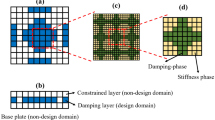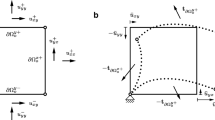Abstract
An application of topology optimization to design viscoelastic composite materials with elastic moduli that soften with frequency is presented. The material is a two-phase composite whose first constituent is isotropic and viscoelastic while the other is an orthotropic material with negative stiffness but stable. A concept for this material based on a lumped parameter model is used. The performance of the topology optimization approach in this context is illustrated using three examples.
Similar content being viewed by others
References
Alabuzhev PM, Gritchin AA, Stepanov PT, Khon VF (1977) Some results of an investigation of a vibration protection system with stiffness correction. J Min Sci 13:338–341
Alabuzhev PM, Grytchin AA, Kim LI, Migirenko GS, Khon VF, Stepanov PT (1989) Vibration protecting and measuring systems with quasi-zero stiffness. Taylor & Francis, New York
Bruns TE, Tortorelli DA (2001) Topology optimization of nonlinear elastic structures and compliant mechanisms. Comput Method Appl Math 190:3443–3459
Diaz AR, Benard A (2003) Designing materials with prescribed elastic properties using polygonal cells. Int J Numer Methods Eng 57:301–314
Drugan WJ (2007) Elastic composite materials having a negative-stiffness phase can be stable. Phys Rev Lett 98:Article 055502
Falnes J (1995) On non-causal impulse response functions related to propagating water waves. Appl Ocean Res 17:379–389
Guest J, Prevost J, Belytschko T (2004) Achieving minimum length scale in topology optimization using nodal design variables and projection functions. Int J Numer Methods Eng 61:238–254
Hsu YL, Hsu MS, Chen CT (2001) Interpreting results from topology optimization using density contours. Comput Struct 79:1049–1058
Jaglinski T, Kochmann D, Stone D, Lakes RS (2007) Composite materials with viscoelastic stiffness greater than diamond. Science 315:620–622
Lakes RS (1999) Viscoelastic solids. CRC, Boca Raton
Lakes RS, Drugan WJ (2002) Dramatically stiffer elastic composite materials due to a negative stiffness phase? J Mech Phys Solids 50:979–1009
Lakes RS, Lee T, Bersie A, Wang YC (2001) Extreme damping in composite materials with negative stiffness inclusions. Nature 1410:565–567
Lee C-M, Goverdovskiy VN, Temnikov AI (2007) Design of springs with negative stiffness to improve vehicle driver vibration isolation. J Sound Vib 302:865–874
Lin C-Y, Chao L-S (2000) Automated image interpretation for integrated topology and shape optimization. Struct Multidisc Optim 20:125–137
Makris N, Inaudi JA, Kelly JM (1996) Macroscopic models with complex coefficients and causality. J Eng Mech 122:566–573
Platus DL (1991) Negative-stiffness-mechanism vibration isolation systems. Proc SPIE 1619:44–54
Prasad J (2007) Design of materials with special dynamic properties using negative stiffness components. PhD dissertation, Michigan State University
Prasad J, Diaz AR (2006) Synthesis of bistable periodic structures using topology optimization and a genetic algorithm. J Mech Des 128:1298–1306
Prasad J, Diaz AR (2007a) Conceptual design of materials exhibiting frequency-induced softening. ASME Proceedings of DETC2007, Paper DETC2007-34299
Prasad J, Diaz AR (2007b) Material design for frequency-induced softening using topology optimization. Proceedings of WCSMO-7, Seoul, 21–25 May 2007
Pritz T (1998) Frequency dependences of complex moduli and complex poisson’s ratio of real solid materials. J Sound Vib 214:83–104
Pritz T (1999) Verification of local Kramers Kronig relations for complex modulus by means of fractional derivative model. J Sound Vib 228:1145–1165
Sharnoff M (1964) Validity conditions for the Kramers-Kronig relations. Am J Phys 32:40–44
Sigmund O (1994) Materials with prescribed constitutive parameters: an inverse homogenization problem. Int J Solids Struct 31:2313–2339
Sigmund O (1995) Tailoring materials with prescribed elastic properties. Mech Mater 20:351–368
Sigmund O (2000) A new class of extremal composites. J Mech Phys Solids 48:397–428
Sigmund O (2007) Morphology-based black and white filters for topology optimization. Struct Multidisc Optim 33:401–424
Svanberg K (1987) The method of moving asymptotes. Int J Numer Methods Eng 24:359–373
Tai K, Prasad J (2007) Target-matching test problem for multiobjective topology optimization using genetic algorithms. Struct Multidisc Optim 34:333–345
Wang YC, Lakes RS (2004a) Extreme stiffness systems due to negative stiffness elements. Am J Phys 72:40–50
Wang YC, Lakes RS (2004b) Negative stiffness induced extreme viscoelastic mechanical properties: stability and dynamics. Philos Mag 35:3785–3801
Yi Y-M, Park S-H, Youn S-K (2000) Design of microstructures of viscoelastic composites for optimal damping characteristics. Int J Solids Struct 37:4791–4810
Author information
Authors and Affiliations
Corresponding author
Rights and permissions
About this article
Cite this article
Prasad, J., Diaz, A.R. Viscoelastic material design with negative stiffness components using topology optimization. Struct Multidisc Optim 38, 583–597 (2009). https://doi.org/10.1007/s00158-008-0308-6
Received:
Revised:
Accepted:
Published:
Issue Date:
DOI: https://doi.org/10.1007/s00158-008-0308-6




